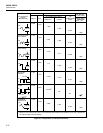
2620A, 2625A
Users Manual
5-6
Monitor Alarm Enabled (Type 2)
This corresponds to the Front Panel ALAr or Computer Interface TRIGGER=2 setting.
When the Monitor Alarm trigger is enabled and the Monitor function is on, a scan is
triggered if the monitor measurement is found to be in alarm. After this scan occurs, a
monitor measurement is again made. If the monitor measurement is still in alarm,
another scan is triggered. This pattern continues as long as the monitor channel remains
in alarm.
Monitor alarm trigger can be used when interval scanning is enabled. This feature is
convenient when you want to take normal scheduled scans and also use the monitor
function as a "watchdog" on a particular channel. Whenever an alarm condition arises on
that monitored channel, the instrument automatically takes additional scan
measurements.
If you change the Monitor function to a different channel while the Monitor-alarm
trigger is in use, measurements on the new monitor channel are used to trigger scans
when the monitor measurement is in alarm. When monitor and scanning are both
enabled, at least one monitor channel measurement is taken after every set of scan
measurements - even in the case of continuous scanning.
Thermal Voltages
Thermal voltages are the thermovoltaic potentials that appear at the junction between
dissimilar metals. Thermal voltages, which can easily exceed 1 uV, typically arise where
wires are attached to binding posts.
With low-level dc voltage and thermocouple temperature measurements, these thermal
voltages can be an additional source of measurement error.
Thermal voltages can also cause problems in the low ohms ranges. Some low value
resistors are constructed with dissimilar metals. Just handling such resistors can cause
thermal voltages large enough to introduce measurement errors.
On Hydra Series II, the rear panel Input Module (channels 1 through 20) contains an
isothermal block to minimize thermal voltage errors. The front connector pair (channel
0), which does not attach directly to this block, is more susceptible to thermal voltage
errors. Use the following techniques to reduce the effect of thermal voltages:
1. Use similar metals for connections wherever possible (e.g., copper-to-copper, gold-
to-gold, etc.).
2. Use tight connections.
3. Use clean connections (especially free of grease and dirt).
4. Use caution when handling the measurement source.
5. Wait for all measurement connections to reach thermal equilibrium. (Thermal
voltages are generated only where there is a temperature gradient.)
When Measuring Resistance or Temperature (RTD)
The instrument can measure a resistance with two or four terminal connections.
Advantages for each configuration are discussed below:
• 2-Terminal Configuration
The instrument measures resistance in a 2-terminal configuration using a resistance
ratio (sometimes called ratio-ohms) technique. Using only the high (H) and low (L)
terminals for one channel, 2-terminal resistance measurements are simple to set up
and yield good results for many measurement conditions. However, if lead wire and
internal relay resistances are significant in relation to the resistances being measured,
the 4-terminal configuration should be used. (Internal relay resistances are noted in
Appendix A, Specifications.) A 2-terminal configuration is illustrated in Figure 5-2.
The full-scale voltage for each resistance range is shown in Table 5-1. The Ve (or
H) input test lead is positive with respect to the COM (or L) lead.


















